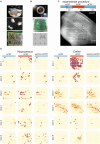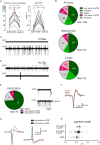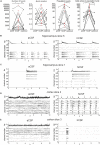Human Cerebrospinal Fluid Induces Neuronal Excitability Changes in Resected Human Neocortical and Hippocampal Brain Slices
- PMID: 32372899
- PMCID: PMC7186381
- DOI: 10.3389/fnins.2020.00283
Human Cerebrospinal Fluid Induces Neuronal Excitability Changes in Resected Human Neocortical and Hippocampal Brain Slices
Abstract
Human cerebrospinal fluid (hCSF) has proven advantageous over conventional medium for culturing both rodent and human brain tissue. In addition, increased activity and synchrony, closer to the dynamic states exclusively recorded in vivo, were reported in rodent slices and cell cultures switching from artificial cerebrospinal fluid (aCSF) to hCSF. This indicates that hCSF possesses properties that are not matched by the aCSF, which is generally used for most electrophysiological recordings. To evaluate the possible significance of using hCSF as an electrophysiological recording medium, also for human brain tissue, we compared the network and single-cell firing properties of human brain slice cultures during perfusion with hCSF and aCSF. For measuring the overall activity from a majority of neurons within neocortical and hippocampal human slices, we used a microelectrode array (MEA) recording technique with 252 electrodes covering an area of 3.2 × 3.2 mm2. A second CMOS-based MEA with 4225 sensors on a 2 × 2 mm2 area was used for detailed mapping of action potential waveforms and cell identification. We found that hCSF increased the number of active electrodes and neurons and the firing rate of the neurons in the slices and induced an increase in the numbers of single channel and population bursts. Interestingly, not only an increase in the overall activity in the slices was observed, but a reconfiguration of the network could also be detected with specific activation and inactivation of subpopulations of neuronal ensembles. In conclusion, hCSF is an important component to consider for future human brain slice studies, especially for experiments designed to mimic parts of physiology and disease observed in vivo.
Keywords: CMOS-MEA; cortex; hippocampus; human cerebrospinal fluid; human tissue; microelectrode array; organotypic slices.
Copyright © 2020 Wickham, Corna, Schwarz, Uysal, Layer, Honegger, Wuttke, Koch and Zeck.
Figures



Similar articles
-
Human cerebrospinal fluid increases the excitability of pyramidal neurons in the in vitro brain slice.J Physiol. 2015 Jan 1;593(1):231-43. doi: 10.1113/jphysiol.2014.284711. Epub 2014 Nov 25. J Physiol. 2015. PMID: 25556798 Free PMC article.
-
Human cerebrospinal fluid promotes spontaneous gamma oscillations in the hippocampus in vitro.Hippocampus. 2020 Feb;30(2):101-113. doi: 10.1002/hipo.23135. Epub 2019 Jul 17. Hippocampus. 2020. PMID: 31313871
-
Neuromodulation of fast-spiking and non-fast-spiking hippocampal CA1 interneurons by human cerebrospinal fluid.J Physiol. 2016 Feb 15;594(4):937-52. doi: 10.1113/JP271553. Epub 2016 Jan 18. J Physiol. 2016. PMID: 26634295 Free PMC article.
-
Significance of Low Nanomolar Concentration of Zn2+ in Artificial Cerebrospinal Fluid.Mol Neurobiol. 2017 May;54(4):2477-2482. doi: 10.1007/s12035-016-9816-3. Epub 2016 Mar 16. Mol Neurobiol. 2017. PMID: 26984599 Review.
-
Establishing a physiological environment for visualized in vitro brain slice recordings by increasing oxygen supply and modifying aCSF content.J Neurosci Methods. 2009 Oct 15;183(2):107-13. doi: 10.1016/j.jneumeth.2009.06.005. Epub 2009 Jun 12. J Neurosci Methods. 2009. PMID: 19524611 Free PMC article. Review.
Cited by
-
Morphotype-specific calcium signaling in human microglia.J Neuroinflammation. 2024 Jul 17;21(1):175. doi: 10.1186/s12974-024-03169-6. J Neuroinflammation. 2024. PMID: 39020359 Free PMC article.
-
Guidelines for Manufacturing and Application of Organoids: Brain.Int J Stem Cells. 2024 May 30;17(2):158-181. doi: 10.15283/ijsc24056. Epub 2024 May 23. Int J Stem Cells. 2024. PMID: 38777830 Free PMC article.
-
Large-Area Field Potential Imaging Having Single Neuron Resolution Using 236 880 Electrodes CMOS-MEA Technology.Adv Sci (Weinh). 2023 Jul;10(20):e2207732. doi: 10.1002/advs.202207732. Epub 2023 Apr 23. Adv Sci (Weinh). 2023. PMID: 37088859 Free PMC article.
-
Electrical Imaging of Light-Induced Signals Across and Within Retinal Layers.Front Neurosci. 2020 Nov 19;14:563964. doi: 10.3389/fnins.2020.563964. eCollection 2020. Front Neurosci. 2020. PMID: 33328846 Free PMC article.
-
Toward the Next Generation of Neural Iontronic Interfaces.Adv Healthc Mater. 2023 Aug;12(20):e2301055. doi: 10.1002/adhm.202301055. Epub 2023 Jul 11. Adv Healthc Mater. 2023. PMID: 37434349 Free PMC article.
References
-
- Agnati L. F., Fuxe K., Zoli M., Ozini I., Toffano G., Ferraguti F. (1986). A correlation analysis of the regional distribution of central enkephalin and β-endorphin immunoreactive terminals and of opiate receptors in adult and old male rats. Evidence for the existence of two main types of communication in the central nervous sys. Acta Physiol. Scand. 128 201–207. 10.1111/j.1748-1716.1986.tb07967.x - DOI - PubMed
LinkOut - more resources
Full Text Sources

